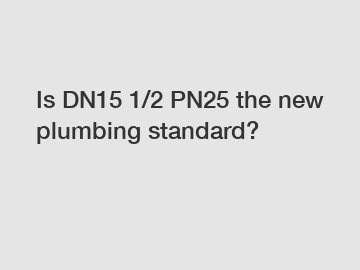Apr. 05, 2024
Is DN15 1/2 PN25 the New Plumbing Standard?
If you're in the world of plumbing, you may have heard some buzz about a new standard that's gaining traction - DN15 1/2 PN25. But what exactly does this mean, and how does it impact the industry? Let's break it down for you in this article.
What is DN15 1/2 PN25?

First things first, let's decipher the code. DN15 refers to the nominal diameter of the pipe, which is 15 millimeters. The 1/2 indicates that the pipe is half an inch in size. Lastly, PN25 stands for the pressure rating of the pipe, which is 25 bars. In simpler terms, DN15 1/2 PN25 refers to a specific size and pressure rating for a plumbing pipe.
Why is it gaining popularity?
One reason why DN15 1/2 PN25 is gaining popularity is its versatility. The size and pressure rating make it suitable for a wide range of applications, from residential plumbing to industrial processes. This means that plumbers and contractors can use this standard for different projects, making their job easier and more efficient.
Additionally, DN15 1/2 PN25 pipes are known for their durability and reliability. The higher pressure rating allows for better performance under challenging conditions, ensuring that the plumbing system will last longer and require fewer repairs in the future.
Related links:How does it compare to other standards?
In comparison to traditional plumbing standards, DN15 1/2 PN25 offers a higher pressure rating, making it more suitable for demanding environments. This makes it a preferred choice for applications where a stronger pipe is needed to withstand the pressure.
Furthermore, DN15 1/2 PN25 is becoming more widely available from various suppliers, making it easier for plumbers and contractors to access the materials they need for their projects. This accessibility is a key factor in the adoption of this new standard across the industry.
Should you make the switch?
If you're a plumber or contractor considering whether to switch to DN15 1/2 PN25, it's essential to weigh the benefits against your specific needs. While this standard offers advantages in terms of durability and versatility, it may not be necessary for every project. It's always best to consult with a supplier or expert in plumbing standards to determine the best fit for your requirements.
In conclusion, DN15 1/2 PN25 is indeed making waves in the plumbing industry, thanks to its versatility, durability, and availability. While it may not be the new standard for every project, it's certainly worth considering for applications that require a stronger pipe with a higher pressure rating.
If you have any questions or need guidance on whether DN15 1/2 PN25 is right for your project, feel free to contact us. Our team of experts can provide you with the information you need to make an informed decision. Get in touch with a supplier today to learn more about this new plumbing standard.
For more wog 1000 pressure rating, gland nut valve, oem lost wax casting stainless steelinformation, please contact us. We will provide professional answers.
Related links:159
0
0
All Comments (0)
If you are interested in sending in a Guest Blogger Submission,welcome to write for us!
Comments